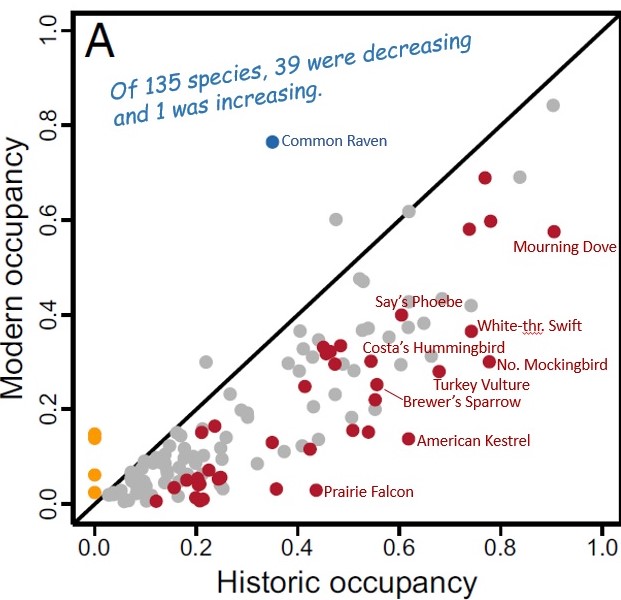Two recent papers concluded that many breeding bird species in southern California and Nevada deserts have declined dramatically due to climate change.
In their abstract, Iknayan and Beissinger (2018) summarized, “We evaluated how desert birds have responded to climate and habitat change by resurveying historic sites throughout the Mojave Desert that were originally surveyed for avian diversity during the early 20th century by Joseph Grinnell and colleagues. We found strong evidence of an avian community in collapse.”

Of 135 species assessed (which included some wintering and migrating species, as well as breeding species), 39 had significantly declined; only one (Common Raven) had increased. This was in stark contrast to similar assessments they conducted of Sierra and Central Valley sites, where more species had increased than decreased and there were no overall declines (not to say there weren’t winners, losers, and range shifts within those regions).

Detailed analyses suggested less rainfall and less access to water was the primary driver. Habitat change only affected 15% of the study sites and was of secondary importance. They found no evidence of expansion of species from the hotter, drier Sonoran Desert (e.g. Phainopepla, Verdin, Black-throated Sparrow) into the Mojave Desert.
Consistent with a community collapse, declines were greatest among species at the top of food chain — carnivores such as Prairie Falcon, American Kestrel, and Turkey Vulture. Insectivores were the next most impacted, and herbivores the least. But the declines affected both common and rare species, both generalists and specialists.

A follow-up study by Riddell et al (2020), also involving Iknayan and Beissinger, focused on the thermoregulatory costs — the water requirements to keep cool — for the declining species. They found that “species’ declines were positively associated with climate-driven increases in water requirements for evaporative cooling and exacerbated by large body size, especially for species with animal-based diets.” Larger species get much of their water from the insects they eat. They estimated larger species would have to double or triple their insect intake to meet their water needs, though insect abundance is lowest July thru September.

Intriguingly, they found that 22 species had actually declined in body size over the last century, consistent with Bergmann’s Rule, and had reduced their cooling costs up to 14%. These species fared better. Current climate change, however, is at least ten times more rapid than any previous warming event, during which many species evolved. They estimated cooling costs have already increased 19% and will reach 50% to 78% under most scenarios, far outstripping any species’ ability to evolve through the current rapid warming.
These results stand in stark contrast to the Pacific Northwest, where many of the same bird species (e.g. Anna’s Hummingbird, Turkey Vulture, Northern Mockingbird) are increasing. This is consistent with projections which generally show individual declines along species’ southern edge and expansions at the north edge of their range (see Audubon climate projection maps for individual species).
Iknayan and Beissinger conclude, “Our results provide evidence that bird communities in the Mojave Desert have collapsed to a new, lower baseline. Declines could accelerate with future climate change, as this region is predicted to become drier and hotter by the end of the century.”

Why not build some artificial oasis’ and small reservoirs with native vegetation nearby to help support them?
LikeLike
Pingback: The song of the Lesser Goldfinch: Another harbinger of a warming climate | The Cottonwood Post